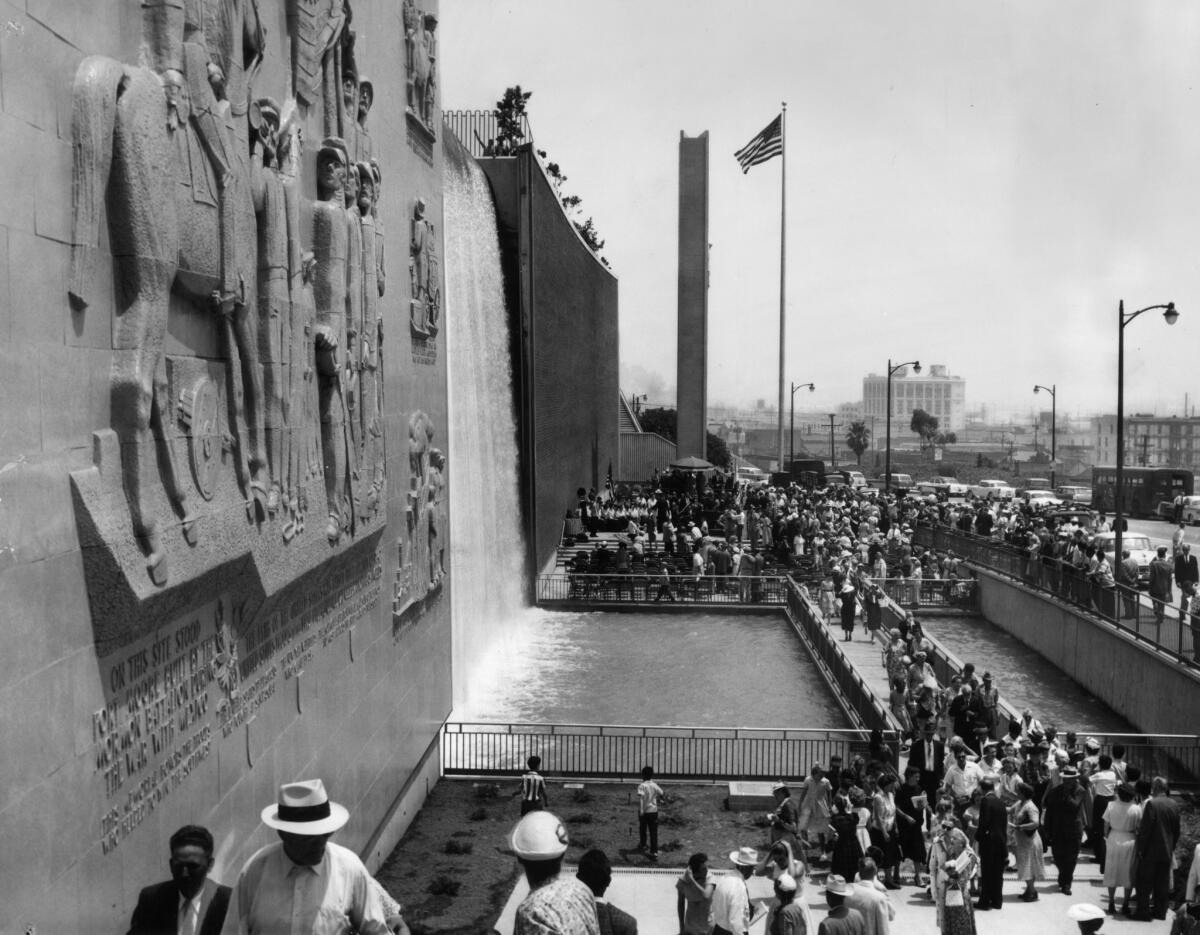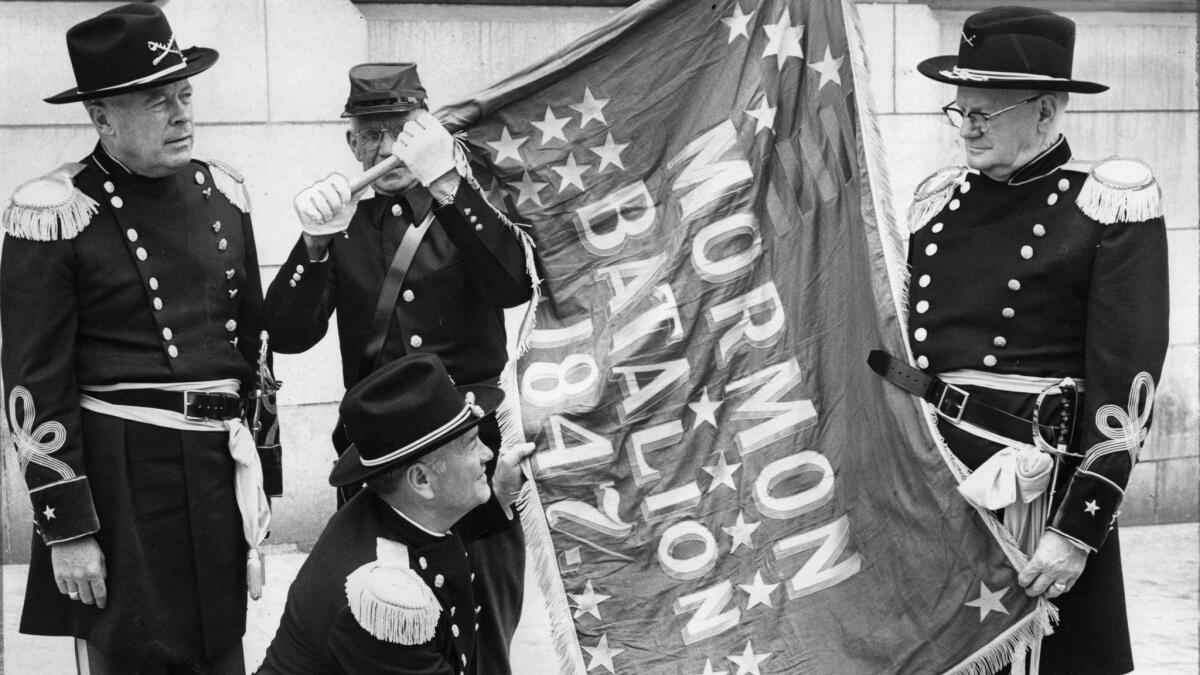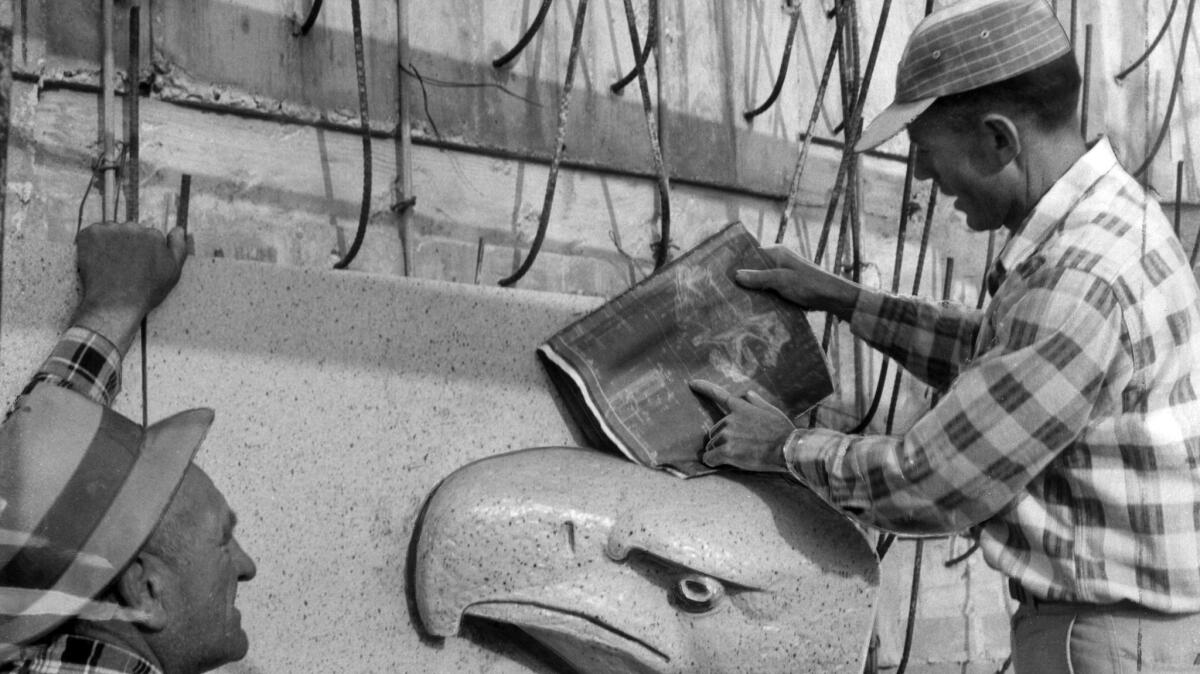After four decades, the drought is about to end for downtown L.A.âs Ft. Moore Hill monument

Itâs so large, itâs easy not to notice it.
Its 400 feet of brick, mosaic tile and glazed terra cotta could be nothing but an odd retaining wall keeping whatâs left of Ft. Moore Hill from falling.
On the speedway that Hill Street becomes between downtown and Chinatown, a motorist could never appreciate the structureâs eloquently worded tribute to military service, the pioneering spirit and California history.
âItâs the most historically and geographically important monument that nobody knows about,â said Clare Haggarty, manager of L.A. Countyâs art collections. âItâs where Los Angeles really began, and itâs huge, and so many people donât know it exists.â
Itâs the most historically and geographically important monument that nobody knows about.
— Clare Haggarty, manager of L.A. Countyâs art collections
Its most distinctive feature, a 77-foot-wide wall of water cascading over multicolored mosaic tiles, has been dry since 1977, possibly contributing to its anonymity.
Now, after 40 years of neglect, the Los Angeles County Board of Supervisors has set aside money to bring the Ft. Moore Pioneer Memorial out of hiding.
Within the next month, scaffolding will rise for the first phase of the renovation, replacing nearly 300,000 tiles that back up the waterfall. Then a shadow of past graffiti will be removed from the brick. Chunks missing from the bas-relief depiction of the cityâs first Fourth of July will be refilled by hand to match the glazed terra cotta. Then, drought or no drought, the water will flow again.
No firm date has been set for the projectâs completion, but it would be fitting if it came soon enough for a rededication on July 4, 59 years and a day after its first dedication.
On July 3, 1958, members of the Mormon Battalion of Salt Lake City, some of them descendants of the original military unit that played a key role in early California, reenacted the first raising of the American flag over Los Angeles 111 years earlier.
The memorial commemorates an episode when a battalion of Mormon volunteers stood guard over Los Angeles. The only religiously based unit in U.S. Army history, it had marched nearly 2,000 miles from Council Bluffs, Iowa, to Los Angeles via San Diego for a war that was over by the time it arrived.
The Treaty of Cahuenga, though not the formal end of the Mexican-American War, brought peace to California in January 1847.
Several months later, the Mormon Battalion, joined by the 1st Regiment of Dragoons and the New York Volunteers, observed the first Fourth of July in Los Angeles by raising the U.S. flag on a pole of two spliced logs that was reputed to be 100 feet tall.
Watch a scene that starts at the 46 minute mark of this 1960s TV show to see what the fountain looked like when it running >>
The event took place on the earthen walls of a fort the soldiers were ordered to build in defense of the city. It was named for Benjamin Moore, an officer who had been killed in a battle near San Diego.
The Mormon Battalion was soon discharged, its place in history secured less for military feats than for blazing a southwest route for the settlement of the new U.S. territory where many of the soldiersâ descendants then settled.

The development of a massive monument was a confluence of two unrelated threads. One was the influence in L.A. society of the Daughters of Utah Pioneers, a group of those descendants, which gained the backing of Los Angeles Times matron Dorothy Chandler and then-L.A. County Supervisor John Anson Ford.
The other was the need for a large wall.
It was a time spanning World War II when a massive reshaping of Civic Center erased much of the areaâs early history. Along with the fort, two early cemeteries and a hilltop neighborhood of Victorian houses belonging to the cityâs elite all disappeared in a series of excavations that began in the 1930s to make way for roads and buildings.
Ft. Moore Hill, which once extended from its current stub east to Spring Street, was clipped several times, the last in 1949 to make room for the new Hollywood Freeway.
The scarp that remained on its east side became the canvas for two immigrant sculptors, London-born Albert Stewart and Connecticut-based German native Henry Kreis, according to the Los Angeles County Arts Commission website.
Kreis, who won a competition for the job, designed the terra cotta relief on the south of the waterfall that depicts the flag raising.
A series of vignettes show the Mormon Battalionâs march, a prairie schooner, a steam locomotive and regional scenes such as orange groves and cattle ranching.
Breaking up the view of the brick wall on the north side, a 68-foot pylon bears the eagle-crested inscription, âTo the brave men and women who with trust in God faced privation and death in extending the frontiers of our country to include this land of promise.â

In what would become an ironic element, one of the vignettes recognizes the Los Angeles Department of Water and Power, a sponsor of the memorial, with the inscription: âWater and power have made our arid land flourish.â
The fountain was turned off in 1977 during a drought. When rains finally returned, it was too late for the 47-foot-tall waterfall. Its mosaic tiles were falling off, and its pumps had been vandalized.
The Pioneer Memorial was all but forgotten, popping up only occasionally in news reports on Fourth of July reenactments of the 1847 flag raising.
In the hope of spurring a revival, a civic group staged an elaborate reenactment in 1997 with nearly 100 costumed soldiers, a 28-musket salute and blast from a period howitzer.
In 2000, at the request of then-Supervisor Gloria Molina, the county did a cost analysis for a restoration. Nothing came of it at the time.
Looking back, Molina told The Times recently, she thought it a shame that the waterfall had been neglected but was conflicted about memorializing the fort. âThatâs where they were shooting at us from,â she said, referring to a clash between soldiers and rebellious campesinos.
She neednât have worried. The fort, erected by hand labor in only a few days, came after the shooting stopped, according to the California State Military Museums website. The battalionâs military achievement, if any, has been characterized by various sources as buffering Los Angeles from a rumored Mexican counterattack or discouraging Gen. John C. Fremontâs aspirations to lead an independent California.
Molinaâs plan got new life in 2014 amid a general revitalization of the north end of Civic Center.
âThereâs so much happening with Grand Park and the Hall of Justice reopening, it was time,â Haggarty said.
The Board of Supervisors committed about $4.1 million, later increased to $5.5 million, and the city added $500,000.
Donna Williams, who was the consulting conservator for the Hall of Justice and Hollyhock House restorations, will oversee the preservation work, ensuring that it follows U.S. Department of Interior guidelines so the memorial can one day be added to the list of historic sites, Haggarty said.
This recent surge of rain may have spared the county the double irony of turning the water back on during another drought.
But officials are mindful of the need to balance the goals of historical accuracy and water conservation, said David Palma, capital projects manager with the county Department of Public Works.
The cascade that originally gushed like a miniature Niagara Falls will be reduced to a thin layer to eliminate spray, and pumps originally immersed in an 80-foot by 30-foot pool at the foot of the waterfall will be moved to a utility room.
No longer will it be necessary to drain the 64,000-gallon reflecting pool to maintain the pumps.
ALSO
Blue-eyed mountain lion kitten is killed by vehicle while crossing 118 Freeway near Simi Valley
L.A. to acquire property known as âcrown jewelâ in river revitalization strategy
L.A. tallies its homeless population amid concern about rising encampments
More to Read
Sign up for Essential California
The most important California stories and recommendations in your inbox every morning.
You may occasionally receive promotional content from the Los Angeles Times.










